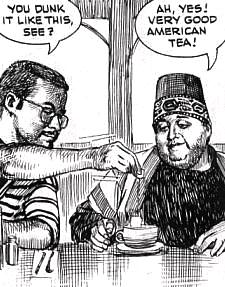Legend: Cultural differences lead to humorous incidents.
Examples:
[Reader's Digest, 1967] The packaging of consumer products, a convenience so familiar to Americans, can be baffling to a foreign visitor. I was lunching in the college cafeteria one afternoon with a young student from India. Noticing that he had torn open his tea bag and emptied its contents into his cup, I explained that the bag itself was meant to be dipped, unopened, into the water. A bit surprised, he thanked me graciously for correcting him — and then confidently dropped an unopened envelope of sugar into his tea. [Vickery, 1997] Nowadays the President of the Irish Republic presents shamrock to members of the diplomatic corps and army on |
Origins: Each
culture has its own peculiar ways of doing things its members take for granted, so it's no surprise tales about outsiders who don't intuitively know these rules find a ready audience. Such tales serve to separate "us" from "them" by illustrating differences between members of one group and another, but they also point out just how arbitrary and sometimes silly those indicators are when viewed objectively.
In North American society, it's unthinkable someone would not know to dunk a tea bag into hot water. In other parts of the world, however, tea

doesn't come in bags; it's provided loose. It is therefore understandable someone coming from such a culture might well think to tear open the tea bag, viewing it the way an American would a plastic packet of mustard. Likewise, it's conceivable a foreigner could mistake a shamrock for a salad ingredient. Our familiarity with those items blinds us to how they would be viewed by someone lacking our preconceptions.
The gentleman in the first example (who, upon correction over the tea bag matter, dunks his sugar packet) applies exquisite logic to help overcome the problem of being a stranger in a strange land.
These faux pas are more than just funny; they identify the one making the social misstep as a foreigner and thus out of place. Yet each culture is fraught with its own pitfalls, and the group patting itself on the back in one story can turn out to be the goat in the next:
She was very proud of the heirloom soup tureen, and always served soup to her relatives when they had a 'reunion' dinner. The only problem I noticed was that it only had one handle. Of course, it wasn't a soup tureen (which traditionally have two handles), but a chamber pot! Was nice looking, though. Told the woman what she had, and she was aghast. Said she'd never tell her relatives what she had done to them. [Collected via e-mail, 2000] An urban legend I heard in New Zealand was about a family that came back from Australia with a neat Aboriginal-made elongated wooden bowl and used it for party snacks. Then one day an anthropologically better-informed visitor pointed out that the two little holes in the side were for a waistband and while it was indeed used for parties where it came from, namely corroborees, it was meant to hold only two nuts.
[Collected via e-mail, 1998]
Barbara "scrotum tote 'em" Mikkelson
Last updated: 17 December 2005
 Sources:
Sources:
 Also told in:
Also told in:The Big Book of Urban Legends. New York: Paradox Press, 1994. ISBN 1-56389-165-4 (p. 215).
